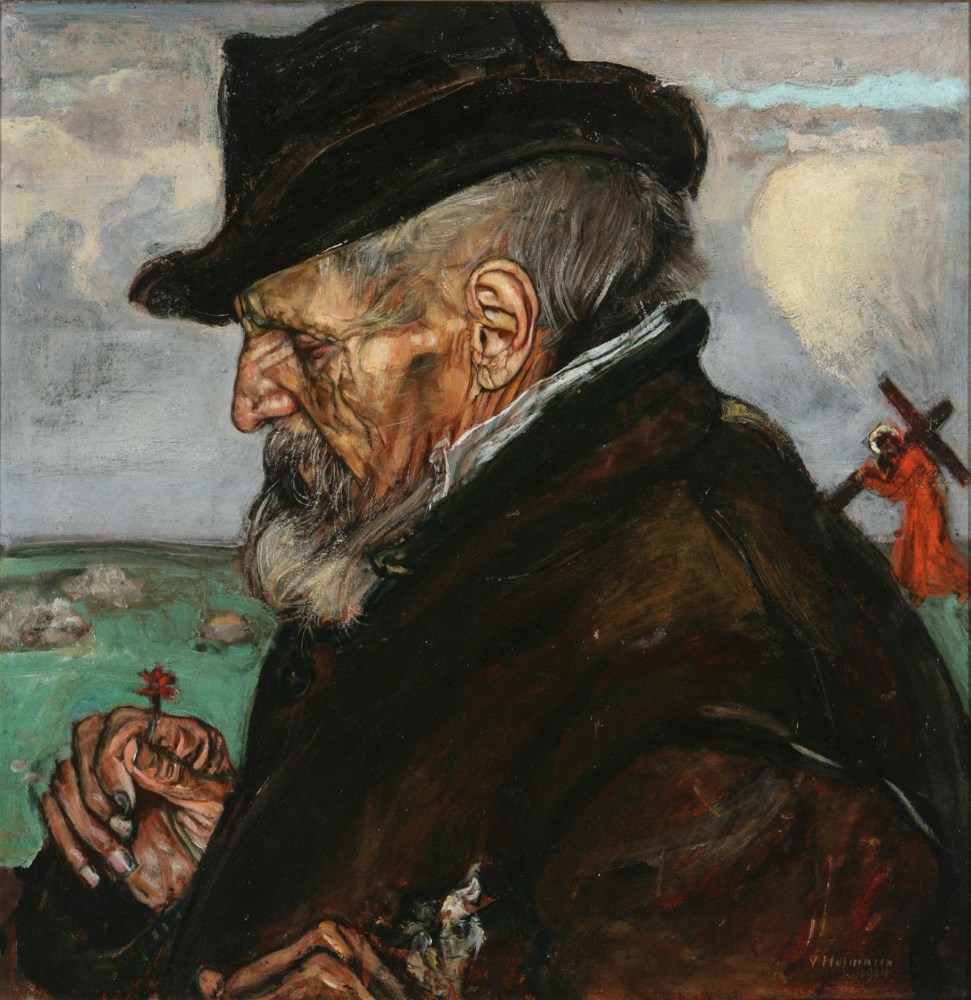Description:
Wlastimil Hofman (1881-1970) was born in Karlin, a suburb of Prague, Czech Republic, to a Czech father and a Polish mother. In 1889 his family moved to Krakow and opened a decorative stone shop in the Sukiennice. From 1895, Hofman attended evening drawing classes at the School of Fine Arts in Florian Cynk’s studio. The following year he left secondary school and, at the age of 16, was accepted into the Krakow School of Fine Arts. During his third year of studies he moved to Jacek Malczewski’s studio and participated in outdoor classes with Jan Stanisławski. He graduated from the school as the top student with the comment: “Hofman is an exceptionally talented individual who is developing quickly and independently”.* That same year he left to study in Paris, where he was a student of Leon Gérôme at the École des Beaux Arts for a year. Due to financial difficulties, he was forced to return to Krakow, where he opened his first studio on Dębniki. In 1905, he founded the Group of Four with Mieczysław Jakimowicz, Leopold Gottlieb and Witold Wojtkiewicz, later renamed the Group of Five (without Wojtkiewicz, with Jan Rembowski and Tymon Niesiołowski). They strived to revive the romantic idea of “correspondence of the arts”, to revive Baudelaire’s concept of the affinity of the visual arts, literature and music. They chose Cyprian Kamil Norwid, a great Polish romantic poet, painter and draughtsman, as their patron. Hofman participated in all the exhibitions of the group, including in Vienna (1906, 1908) and Berlin (1907). After the outbreak of the First World War, he left with his father for Czechoslovakia. In the summer of 1917 he returned to Poland. After some critical reviews at his first post-war exhibition, he decided to go to Szklarska Poręba, where he stayed until his death – the painter died in 1970, exactly two years after his beloved wife Ada Hammerowa.
Description of the painting:
Nearly the entire square of the painting is filled by the bust of an old man depicted in profile. The realistically, almost photographically treated face with a grey beard and unkempt hair contrasts with the strong, dark-brown stains of the coat and hat. The hunched man looks from under his closed eyes at a tiny red flower that he holds in his right, worn hand. The wrinkled hand with traces of dirt under the fingernails, in its naturalistic portrayal is connected to the wrinkled face of the model. Its realistic completion is the white line of the rumpled collar of the shirt, which corresponds to the roughly treated, whitish-blue cuff of the coat. This detail determines the social position of the one depicted. It also breaks up the dark spot of the coat, at the same time harmonizing with the colour of the clouds swirling in the background. The clouds covering the blue sky are painted with a synthetic colour spot, which is clearly separated from the strongly outlined head of the old man. The fresh green of the vast field is then a similar, synthetically rendered colour background for the detailed painted hand and the red flower with its tattered petals. Thanks to this, we recognize it as a carnation. Its colour counterpart is the robe of Christ bending under the weight of the cross behind the old man.
The key to deciphering the titular “Legend” – a story usually based on folk tales – is the carnation. Its Latin name Dianthus comes from Greek and means “God’s flower”. It may refer to both the figure of Christ and his Passion. According to a medieval legend, Mary’s tears that fell to the ground during the Crucifixion turned into carnations. Due to its shape, it began to be universally known as “nails” and associated with Christ’s Passion.
So, the old man immersed in contemplation of the vanity and transience of life, here embodied by the delicate flower, finds consolation stemming from faith and hope in the resurrection. And in both the Christian and cosmic dimension, symbolized by the spring fields indicating the eternal rebirth of nature. The discussed painting is a perfect example of the psychological portraits of simple, grey people in their everyday pilgrimage, so often painted by Hofman. The lyrical mood of contemplation, silence, peace and acceptance of destiny hints at the spiritual depth of the model marked by the experience of the whole earthly life, which inevitably leads to death. This interpretation corresponds to the shape of the canvas. For in Christianity, the square symbolizes the inevitable death, but also the heavenly Jerusalem.
In this sense, “Legend” is also an excellent example of Hofman’s religious painting, which was an essential part of his work. He believed that art was a service to God, and religious themes its most important expression: “My art develops around prayer, around the encounter of human spirit with God (..) Prayer of spirit and body are the highest manifestations of a human being, the most worthy to be presented in art. ”.
“Legend” is finally a reflection of Hofman’s fascination with the work of his teacher Jacek Malczewski. It is enough to compare it to the “Skylark” discussed a few days ago, or Malczewski’s triptych “Three Heads” from the same year, also from the Rogalińska Gallery. We see in them the same way of framing figures against the backdrop of the Polish landscape populated by angels and saints. However, the selection and interpretation of the figures differ, as contrary to Malczewski’s models they do not contain any trace of extraordinariness connected with the social or professional status of the depicted. Hofman focuses on the characterisation of simple people. To this end, he uses expressive means, which bring his work closer to the popular art he was so fascinated with.


